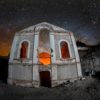Mexico, Guatemala and Belize offer amazing activities around crystal-clear cenotes, volcanic lakes, travertine waterfalls, deep canyons and turquoise rivers. These wonders are surrounded by lush jungles and, due to the limestone terrain, their waters have a splendorous turquoise colour during the dry season.

This rainforest region offers some of central Mexico’s most breathtaking scenery, with extraordinary sinkholes and turquoise waterfalls.
Around this area, we will swim at Puente de Dios, a stunning pool of clear water containing a cave whose interior lights up due to the light filtering between the rocks. Moreover, canoeing Santa María River to the majestic Tamul Waterfalls is an experience to remember. Finally, we will hike to the Cave of Swallows, the largest known shaft in the world, which provide refuge for thousands of white-collared swifts and green parakeets.
Hidden in the lush mountainous jungle, Semuc Champey is a cluster of tiered pools above a natural limestone bridge. Far from any major cities, this area has a truly different feel from anywhere else in Guatemala. People visit Semuc not only to enjoy swimming in the pools but also to explore the nearby water cave, or tube down the Cahabon River which disappears under a limestone bridge.

Hierve el Agua is a set of infinity pools at the top of spectacular ‘frozen’ waterfalls. All in all, hicking around the place to observe this wonder from the Zapotec sierras and taking a swim in its mineral waters is one of the most rewarding experiences at Oaxaca State in Mexico.
The jungle of southern Mexico contains a system of underground rivers that connects over 30,000 Km of natural sinkholes. Once revered by the ancient Mayans, they are now magnets for adventurers and explorers.
When choosing Lupita for your adventure, you will be able to explore some cenotes such as the Ik-Il Cenote, whose vertical walls are lined with vines, and the Dzitnup Cenote, with its ray of natural light in the middle of the pool. In addition, the Grand Cenote near Tulum has tunnels connecting open-air areas and underwater limestone formations. Bejil-há community offer an out-of-the-beaten-path cenote experience, on which we will explore an underground river. Finally, the open cenotes of Bacalar Lagoon, with their unique splendour, are some of the biggest in Mexico!

No trip to Guatemala is complete without a visit to Lake Atitlan, described as “the closest thing to Eden on Earth”. Situated in the Sierra Madre mountains, the lake offers fern-covered valleys, towering volcanoes and Mayan towns with rich indigenous culture.
The Lower Mayan Trail, covering the Kachekel Mayas’ ancient paths, is the best choice for a tour around Lake Atitlán. During this hike, we will encounter farmers tending their coffee fields and the breathtaking views of the volcanoes. To finish the adventure, we will tour a local school, a typical family home, and a vocational training centre from Amigos de Santa Cruz, a non-profit organization that helps local children.

The stunning lagoon of Bacalar offers an ideal space for swimming, diving and snorkelling. This is one of the best spots in the Riviera Maya – and there are seven reasons why. The lengthy, narrow lake forms no less than seven different shades of blue. With its white limestone bottom, the water is famously clear. Moreover, its open cenotes, with their unique splendour, are some of the biggest in all of Mexico!

Rio Dulce is an imposing biological corridor that links Lake Izabal with the Guatemalan Caribbean Sea. This protected area is recognized mainly for its spectacular beauty and for being the habitat of several species of fauna. In addition, the canyon, surrounded by lush tropical rainforests, runs through up to 60 meters high limestone walls.
To get to our accommodation, which is only accessible by boat, we’ll do a river tour along the canyon. Moreover, we will as well hike to the Tiger Cave and get by canoe to El Golfete hot springs. Last but not least, we will explore the interesting Garifuna town of Livingston.

For a bathing experience like no other, head to Tolantongo in Mexico, a box canyon rising 1,640 feet (500 metres). Here, a river naturally heated by volcanic activity feeds a series of turquoise infinity pools that spill down from the surrounding cliffs.
One of Chiapas’ stand out nature destinations is the Sumidero Canyon, whose walls are over 1,000 feet high. Several endangered species make their home in the area and there are dozens of waterfalls. All in all, this is an incredible natural landscape to enjoy while on a boat tour departing from the village of Chiapa de Corzo.

This unusual geological formation from Hidalgo State, Mexico, is a set of tall basalt columns through which a stream of water runs. Located in a scenic ravine, the cluster of thin, matchstick-like columns owes its striking form to the slow cooling of volcanic lava.
Real de Catorce is now one of Mexico’s most famous ghost towns. The territory surrounding this village is of vital importance to the Huichol people. Every year, members of the tribe scour the region in search of peyote, a psychedelic cactus that they regard as a deity.
